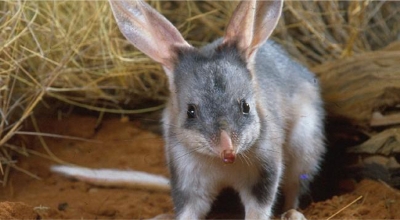
The lesser bilby, also known as the yallara, the lesser rabbit-eared bandicoot or the white-tailed rabbit-eared bandicoot, was a rabbit-like marsupial. The species was first described by Oldfield Thomas as Peregale leucura in 1887 from a single specimen from a collection of mammals of the British Museum. Reaching the size of a young rabbit, this species lived in the deserts of Central Australia. Since the 1950s–1960s, it has been believed to be extinct.
The lesser bilby was a medium-sized marsupial with a body mass of 300–435 grams, a combined head-body length of 200–270 millimetres and tail from 120 to 170 mm. Its fur colour ranged from pale yellowish-brown to grey-brown with pale white or yellowish-white fur on its belly, with white limbs and tail. The tail of this animal was long, about 70% of its total head-body length.
Macrotis have long fur with a silky texture, the species have long tails and mobile ears that resemble those of a common rabbit (lagomorphs); they are burrowing animals that have long and narrow muzzles. The overall coloration of this species was more subdued than the bilby, Macrotis lagotis, and smaller in size; the shorter ears of M. leucura measured 63 mm from base to tip. The underside of the tail had a greyish patch at the base, but the long and bushy fur is otherwise white.
An illustration reconstructing the animal in its native setting was painted by Peter Schouten.
Picture Credit : Google




